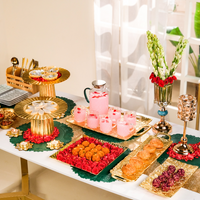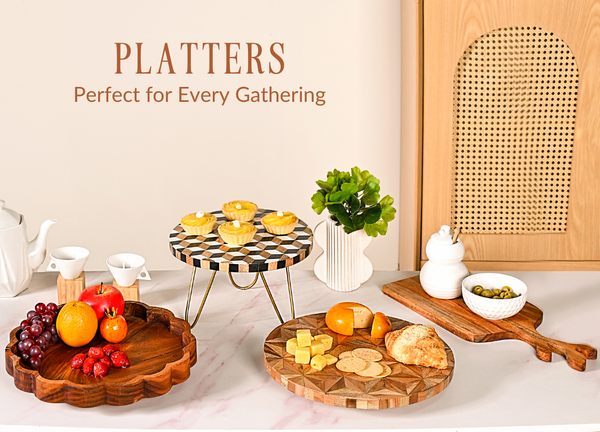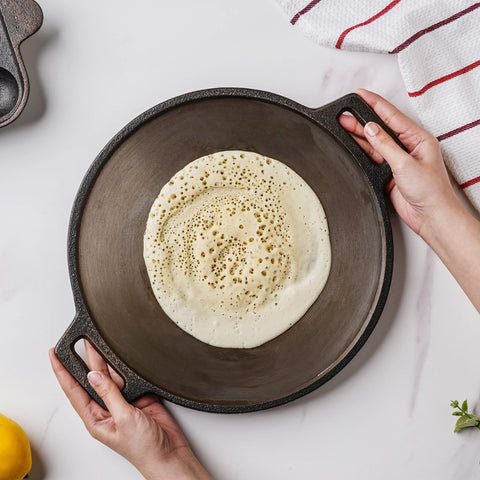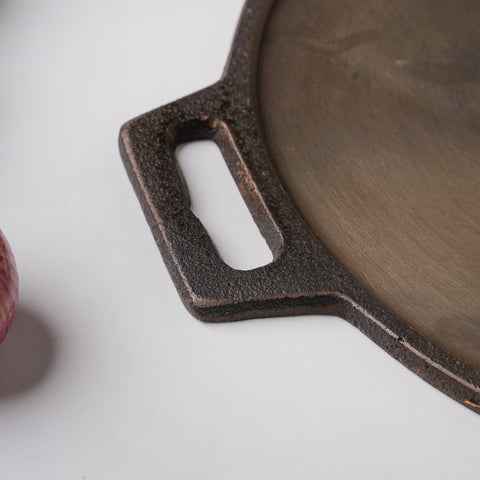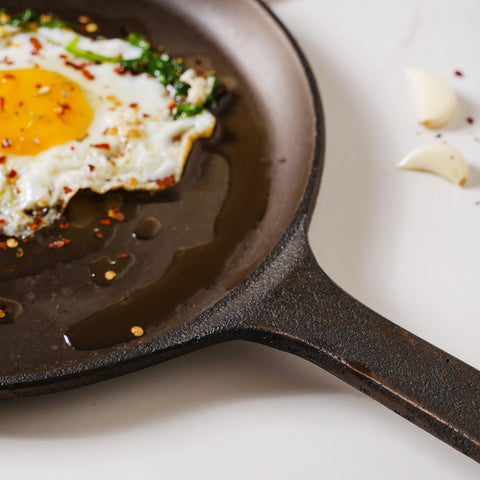Cast iron cookware has been extremely popular in households and has often been the product of family heirlooms too as they can literally last for generations! Cast iron is adaptable, strong, chemical-free, and, with appropriate maintenance, will last for years. It works just as well over a campfire as it does on the stovetop or in the oven. Cast iron pans are the perfect cookware for searing steak or achieving a gorgeous, golden crust on your pizza because it distributes heat equally and perfectly.
Make your classic comfort food with enhanced flavours while also making it healthier with just a simple change to the material of the dish you cook in. The more you cook on a cast iron, the better it gets and cooking techniques that use oil are the best options. To ‘Make Your Home Special’ and your cooking skills more refined, cast iron pans are the perfect accessories. Hold on if you’re thinking twice about welcoming a cast iron girdle to your kitchen because we at Nestasia have listed easy maintenance tips, their benefits, and some bonus yum recipes.
5 Benefits of Cast Iron: Health and Convenience
Free from nasty chemicals
When going for non-stick cookware, Teflon-coated non-stick pans may be the go-to option for their increased popularity but, they release perfluorinated compounds (PFCs) when heated and scratched surfaces from daily use may leach the chemicals with food, leading to ingestion. According to studies and research, PFCs have been proven to cause health problems. However, cast iron pans with their 100% natural metal built are absolutely chemical-free.
Requires less oil for cooking
A well-seasoned cast iron cookware presents a smooth sheen, making the cast iron utensils naturally non-stick. Hence, copious amounts of oil won’t be required to fry or sear food items. Less oil is good for the heart as well as for the diet. The cast-iron cookware by Nestasia is pre-seasoned with vegetable oil and requires the occasional seasoning. Read on ahead for the detailed seasoning process.
Increases iron content in food
Cast iron boosts the iron level of meals nutritionally, especially acidic food like tomato sauce and food items cooked for a more extended period. According to a study, when prepared on an iron pan, even non-acidic and easy-to-cook meals like eggs and fried potatoes had an iron level that was five times higher.
Easy to clean
Cleaning a cast iron cookware is as easy as it gets. Take the pan to the sink, after it has cooled down, under warm running water (ideally holding the utensil by the handle), and use your metal spatula to scrape out any food residue. Place the pan on the burner to dry. Finally, dab a paper towel with little oil and wipe the cast iron cookware’s surface.
Even cooking temperature
The weight of cast iron pans, makes them retain heat for a longer period of time than most other materials of cookware. This is effective whether you are frying a crepe or searing a steak at a high temperature. A cast iron cookware will prevent you from accidentally burning the base of the food item if it requires a longer cooking time, as the heat distributes evenly through a cast iron cooking dish.
Maintenance Tips to Get that Cast Iron Sheen
Science of Seasoning
When several layers of oil are baked onto the skillet, a rust-resistant and nonstick surface is produced, and the process known as "seasoning" of cast iron takes place. Most new skillets have factory-applied seasoning, but you may have to re-season it after extended use.
- Preheat the oven to 400°F.
- Sprinkle salt into the pan.
- Scrub the salt into the pan's surface using the potato's flat side. Any dirt or rust that cannot be removed by wiping away or scraping can be helped to remove by the moisture from the potato coupled with salt.
- Use a slightly damp paper towel to wipe the salt from the pan.
- Once the salt has been removed and the pan is dry, pour in the oil.
- Oil should be applied to the pan's whole surface, including the inner sides, edges, and handle, using a paper towel. There should be no excess oil pooling on the cookware’s surface.
- Place the skillet in the oven for an hour at 400°F after thinly coating it with oil. Let the cast iron cookware cool before wiping out any extra oil that might have remained.
And voila! The pan is seasoned and ready to use.
(P.S. - There’s no need to re-season the cast iron after or before each use unless it’s starting to rust or appear dull.)
Scrub-a-Dub-Dub
Although many cast iron users believe it's best to clean cast iron just with water, you can also wash the cookware with some mild detergent. Whichever method you pick, be careful not to scrape or scrub the pan too harshly or to completely immerse it in water, as it may remove the seasoning. To remove food stuck on the pan, it’s advisable to remove it by scrubbing the cast iron with salt.
If cast iron isn't quickly dried after washing, it will rust. Hence, it’s advisable to dry the cast iron with a paper towel. To remove any leftover moisture, put it on the burner for a few minutes over low heat. You may also wipe the cast iron pan with a paper towel dipped in oil to restore any lost seasoning.
Keeping the Cast Iron Safe
Much more significant than where you keep your cast iron is how you do so. Prior to stacking or hanging your cast iron, it must be ensured that it is completely dry. Your well-earned seasoning is at war with rust! Secondly, while storing a skillet with other pots and pans, it’s advisable to tuck a single paper towel inside as it shields the pan's surface and absorbs any moisture.
Yum-Tum Recipes on Cast Iron
Quirky Taco-Dosa
Cast iron is the go-to cookware when it comes to making crispy tasty dosas. Dosa made in a cast iron pan tastes much better in terms of taste and texture. We at Nestasia have put forward our best twist to the classic dosa recipes. Click on the video for some quirky small taco dosa ideas.
Traditional Crispy Paniyaram
Paniyaram, a specialty from Tamil Nadu, cooked with fermented rice and lentil batter, is best paired along with some coconut chutney, tomato chutney, or sambhar. The cast iron pan specially designed for paniyaram known as a paniyarakkal, makes for yummy, and fluffy paniyaram balls. The cast iron pan with its even heat spread gives a crispy layer to the paniyaram. With leftover dosa or idli batter, you can quickly make these delightful shallow-fried batter balls and have a delicious breakfast.
One-'Kadai' Fried rice
Fried rice cooked in a cast iron kadai enhances the flavours of the vegetables, sauces and the spices added to the rice. Firstly, add a tablespoon of oil to the cast iron kadai and let it heat. Following this, add egg to the kadai, and scramble it. Next, sauté the diced vegetables of choice, some onion, and garlic. Following this, add your day-old rice, salt, and drizzle some soya sauce and vinegar into the kadai. Mix and toss all the components and serve hot steaming fried rice in our exquisite serving bowls.
Crispy Crust Pan Pizza
Revolutionise your home-cooked pizza with the cast iron pan with handles. The high retainment of heat and equal distribution results in a truly crispy pizza crust.
Firstly, preheat the cast iron pan in the oven for about 15-20 minutes. Meanwhile, roll and stretch the dough into a circle to fit the pan. Remove the pan from the oven with care and carefully layer it with oil using a paper towel (and tongs to be extra careful, or wear oven mitts). After gently transferring the dough to the pan and pushing it up the sides, spread the pizza sauce evenly over the dough, covering the borders as well. Sprinkle some grated mozzarella on top and put pepperoni or veggies of choice on the top. Apply oil to the dough that is exposed. Bake for 12 to 14 minutes in the oven until golden brown.
Nestasia’s Cast Iron cookware with its multipurpose feature of cooking, baking, and searing gets the crown in the kitchen. With longevity and health benefits as a bonus, cast iron pans and kadai are the epitomai of utility combining form and function with their sleek finish. Get creative with cast iron and experiment with dishes like fried chicken, cakes, lasagna, sandwiches, or some desi delicacies like biryani, chicken tikka, naan bread and savour them to your heart’s desire.









